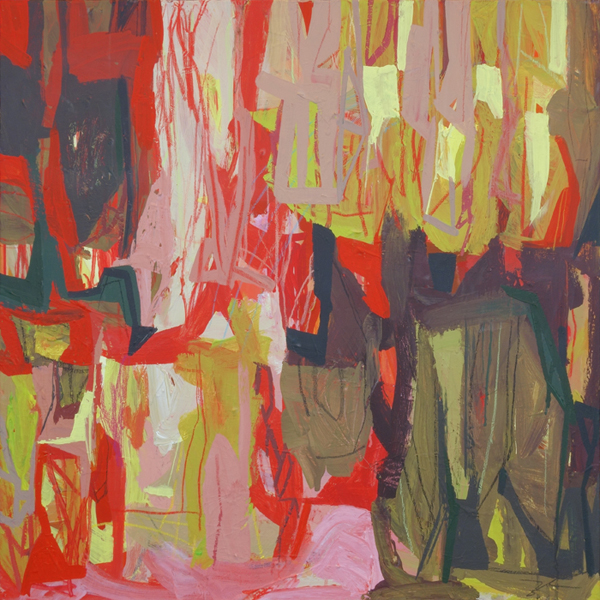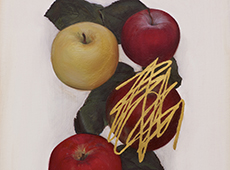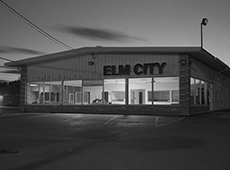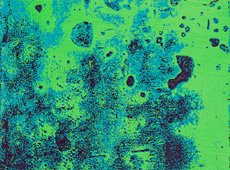Eventually a structure that pleases me starts to emerge. Sometimes shallow space, sometimes deeper space reminiscent of a landscape or an interior. I want imagery in my work to be difficult to pin down…I want the viewer to be able to enter into an open-ended dialogue with the work, the same process that brought me to its completion.

Jay Zerbe, “organicRefraction.” Acrylic and crayon on canvas, 30 x 30 in. 2013.
© Jay Zerbe. Courtesy of the artist.
As is often the case with my work on canvas, this painting has many layers of paint. One of the things I like about working in acrylic is the ability to build up multiple layers in a short amount of time (hours vs. weeks, with some other materials).
I start every painting by applying color with expressive marks and variations in transparency over the entire surface, as well as the edges of the canvas. I use whatever paint is still wet on my palette, as well as selectively adding paint from small containers holding unused paint from prior painting sessions. For this first layer, always quite thin, I use acrylic with matte medium and lots of water. Besides providing a more neutral background to work on (vs. pure white), this layer also helps to smooth out the texture of the medium texture canvas to be quite smooth – the surface texture that I prefer.
Eventually a structure that pleases me starts to emerge. Sometimes shallow space, sometimes deeper space reminiscent of a landscape or an interior. I want imagery in my work to be difficult to pin down…I want the viewer to be able to enter into an open-ended dialogue with the work, the same process that brought me to its completion.
Sometimes the arbitrary patterns of the first layer inspire me to use their flow/stains as the basis of an initial composition. Or I sometimes create an arbitrary composition, drawing on a fragment of an object in my studio, or simply a spontaneous flow of marks and shapes. I take very little care with the first composition, knowing that most likely it will be completely eradicated by subsequent layers.
In subsequent layers, I intuitively add marks and shapes, always being aware of controlling the brush or crayon to make what I feel are expressive calligraphic marks. I have been strongly influenced by Asian brushwork. I sometimes mimic writing movements magnified to large scale when applying paint. Often I introduce rough or awkward-looking mark making to keep the surface lively. Layer by layer the painting builds up a rich surface. I rarely use medium mixed with my acrylic. I use water to thin the paint, and that allows me to build up multiple layers without creating thick paint where I don’t want it.
Eventually a structure that pleases me starts to emerge. Sometimes shallow space, sometimes deeper space reminiscent of a landscape or an interior. I want imagery in my work to be difficult to pin down. I like my paintings to remind me of things without actually showing me anything recognizable. I want the viewer to be able to enter into an open-ended dialogue with the work, the same process that brought me to its completion.
Jay Zerbe has been making paintings and prints since 1968. His work has been widely exhibited in galleries and venues across North America and in the Mideast, including Beirut, Chicago, Detroit, New Orleans and New York City.
Editor’s Note:
Jay Zerbe kicks off a new and needed thread today on Tilted Arc: Process–as motivator and method. Part of our ongoing discussion on the Possibilities of Painting.
Subscribe to Tilted Arc
If you like this story, please consider subscribing. We are sticklers for privacy.
We will never sell or share your e-mail address.



